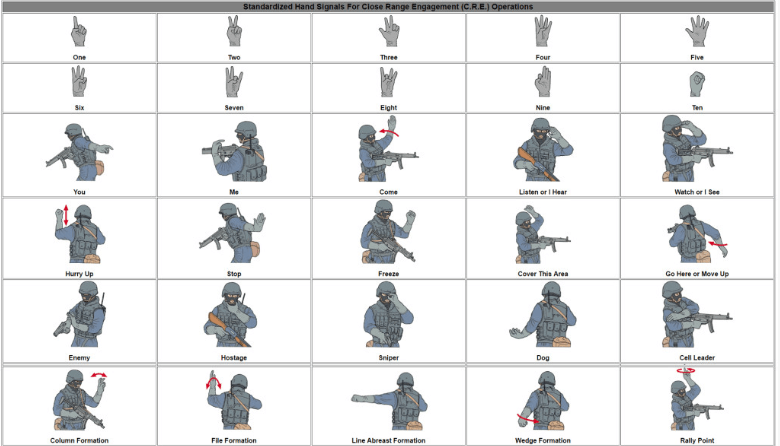Infographic: Hand Signals for Close Combat

Discover 43 Hand Signals for Silent Communication
Mastering the art of silent communication is a crucial skill for survivalists, whether you’re in a high-pressure situation confronting armed adversaries or simply attempting to keep your whereabouts hidden from onlookers. Hand signals provide an effective means of achieving this objective, but it’s essential to commit these signals to memory in advance. Otherwise, you risk flailing your arms in futility, failing to convey any meaningful message.
The accompanying infographic depicts a collection of hand signals utilized by certain SWAT teams and law enforcement agencies. It should be noted that there is no universally-accepted set of standard hand signals, and the signals are subject to variation across different organizations. Nonetheless, this guide can serve as a solid foundation of knowledge about some of the more frequently-employed close combat hand signals. It’s advisable to familiarize oneself with a variety of hand signals in order to increase the chances of clear communication and swift execution in high-pressure situations. In addition, proper training and practice are essential to ensure mastery of these silent communication techniques. Ultimately, the ability to communicate effectively without drawing attention to oneself can be a valuable asset for anyone operating in challenging environments.


It’s worth noting that the hand signals highlighted in the previous infographic can be easily misinterpreted or assigned completely different meanings, as hilariously demonstrated in a popular parody version that has been circulating on the Internet for years. In unpredictable situations, such as those encountered in survival scenarios or combat, it may be necessary to convey unorthodox instructions to teammates or allies, and the use of unconventional hand signals could prove advantageous. While it’s important to maintain a serious approach when communicating via hand signals in high-stress environments, a humorous parody can serve as a reminder of the flexibility and versatility required to make split-second decisions and assessments in chaotic circumstances. Ultimately, the ability to adapt and improvise is an essential component of any survivalist’s skillset.
On a more serious note, it’s highly advisable to study the hand signals presented in the previous infographic if there’s a possibility of finding oneself in a situation involving armed confrontation or home-defense. Familiarizing oneself with these signals along with friends and family members could make all the difference in a crisis scenario. Although it’s unlikely that one would need to signal something as alarming as “six enemies, cover this area”, being prepared for any eventuality is crucial. Investing the time and effort required to master these hand signals can serve as a valuable insurance policy in case of emergencies. In such situations, clear communication could mean the difference between life and death. In the end, it’s always better to be over-prepared rather than under-prepared.








